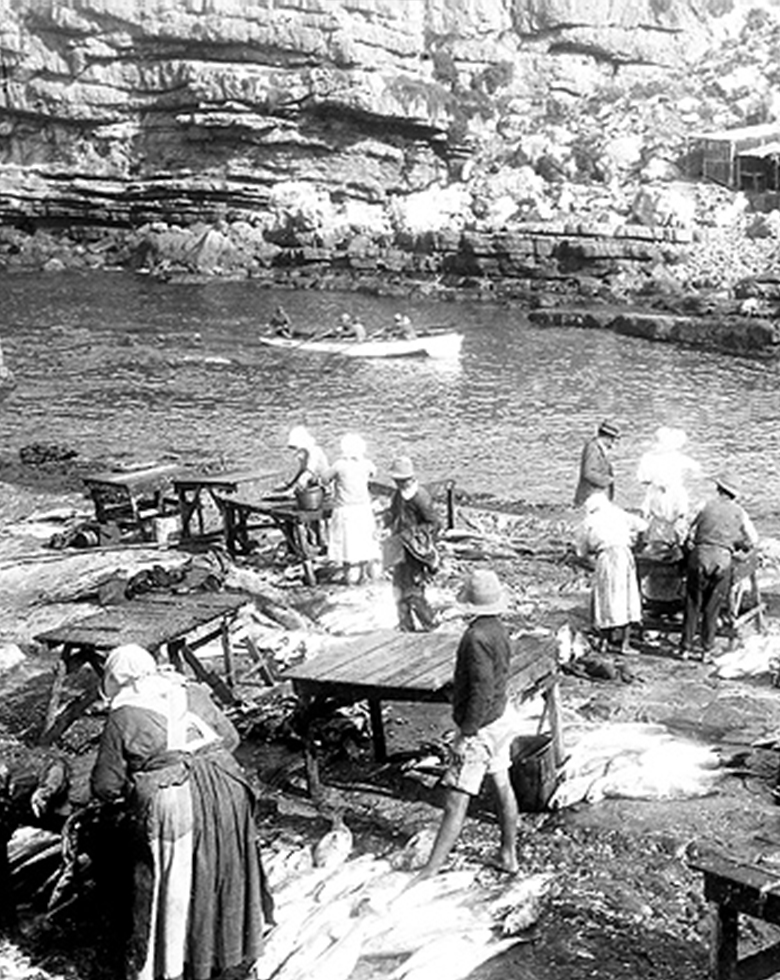The Museum consists of 2 Sections:
The Historical Old Fishing Harbour and Fishermen's Village.
THE INDOOR DISPLAYS: Houses some of the items used in the Fishing Industry in the early part of the century plus the "Selkirk Collection". Selkirk was a world famous Angler and Shark Catcher who lived in Hermanus. The Old Harbour was the centre of activity of Hermanuspietersfontein when as long ago as 1857 it provided shelter for fishing boats whose owners were drawn here by the abundance and variety of fish. This faded after the building of the New Harbour. In 1970 the Old Harbour was declared a National Monument.

The Old Harbour Museum includes an open-air museum which is open 24 hours a day with boats, old sea wall, brine tanks and "bokkom" stands as well as an indoor museum. This houses exhibitions on natural history and the cultural history of Hermanus, including angling and fishing paraphernalia.
The cottage on the Fishermen's Village houses a photographic exhibition of Old Hermanus dating as far back as the late 1860's and includes prints from glass negatives taken by the famous photographer T D Ravenscroft whose studio was in Main Road. The Selkirk Room in the cottage is devoted to the trophies and memory of Bill Selkirk, including the jaws of his world record-breaking shark. All the furniture displayed in the cottage belonged to Meester Paterson a leading figure in Hermanuspietersfontein at the turn of the century.
As long ago as 1857 the Old Harbour at Hermanuspietersfontein provided a rocky but safe shelter for the small fishing boats whose owners were drawn to Hermanus by the abundance and variety of fish. Indeed, without the Old Harbour, Hermanus would have been a very different place. For more than a century, the return of the fishing boats to the rocky inlet was the event of the day. The boats often had to ride outside the harbour in heavy seas, waiting for a break between swells before they could row in to land their frail craft. Large crowds gathered to watch this fascinating daily ritual as the catches were carried ashore and gutted and sold on the spot, while the boats were lifted and placed on the turning-stone before being carried up the slipway by sixteen men - eight fore and eight aft - straining under the carrying-poles. Some of the fish was salted and dispatched in crates for sale in other towns, while snoek and harders were salted and dried on "bokkom" stands in the harbour area and in the backyards of the fishermen.
A new harbour was built some two kilometers to the west in the nineteen-fourties and gradually the fishermen forsook the old "visbaai" for the greater convenience of the new breakwater. In 1970 the Old Harbour was declared a national monument and in 1972 the development of the area as an open-air museum was begun.
By its very nature, the Old Harbour Museum is an all-weather open-air museum, open 24 hours a day. An indoor exhibition is open to the public seven days a week and provides interesting information.

Old Harbour Museum
Without the Old Harbour, there would have been no Hermanus - or Hermanuspietersfontein, so called after the wandering shepherd who watered his flocks at a spring on the cliffs towards Westcliff. As long ago as 1855 the harbour provided a rocky but safe shelter for the small fishing boats whose owners were drawn to Hermanus by the abundance and variety of fish.
The boats
These boats are fragile and precious - help us look after them. All the boats in the harbour, with the exception of Nellie II, are examples of the type of boat used in the Old Harbour between 1855 and 1961. At first they depended on sails and oars, but later some were equipped with inboard engines, usually a Kelvin Marine. An examination of the back of the keel, through which the shaft for the screw passed, will show whether the boat was converted to use a marine engine. The boats Debbie, Tunny, Deppie and Rosebud all show a cut-out section for a mast in the second thwart. Slats from the thwart to the floor of the boat kept each fisherman's catch separate. Several of the boats show the marks of successful fishing lines under strain gouged into the wood. Nellie II is a clinker-built (the boards overlap each other) life-boat. Built in World War II, she is a reminder of the life-boat Nellie I which rescued the survivors of the H.M.S. Birkenhead disaster off Danger Point in 1852.

Intertidal zone
This is the area between high- and low-tide watermarks. Varieties of limpets, starfish, sea urchins, anemones, sponges, worms, periwinkles barnacles, chitons, whelks, mussels and crabs are specially adapted to live in this zone of regular dry and wet periods and in the rock pools. Low tide provides ideal conditions for seeing these creatures in their natural habitat, but... please do not disturb them!
Vision, Mission and Objectives
View the Vision, Mission and Objectives of The Old Harbour Museum.
